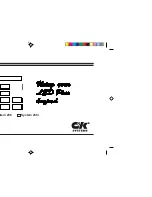
EVO Control Panel
7
Across Separate Buildings:
Strip the outer jacket at one end of the
shielded cable to expose the shield. In the same building as the control
panel, connect the exposed shield to any earth ground available, while
leaving the shield at the other end of the cable open (floating). The same
configuration applies for any subsequent building.
2.16 Fire Circuits
Assign the smoke detectors connected to the control panel or zone
expansion input terminals to a zone and define the zone's parameters as a
Fire Zone (see
2.16.1 Smoke Detector Installation (2-Wire)*
PGM1 can be defined as a 2-wire
smoke detector input (see
on page 29). Connect the 2-wire smoke
detectors as shown in
. If a line
short occurs or the smoke detector
activates, whether the system is armed
or disarmed, the control panel will
generate an alarm. If the line is open,
the “Zone Fault” trouble indication
appears in the Trouble Display and the
report code is sent to the monitoring
station, if programmed.
*
UL Note:
Not to be used with UL Listed systems.
2.16.2 ESL CleanMe
®
Installation
Connect ESL smoke detectors like the standard smoke detectors. Avoid
connecting more than 20 ESL smoke detectors. When an CleanMe signal
is sent, the control panel will generate a Zone Fault trouble and may
transmit the Fire Loop report code to the monitoring station. The trouble will
be cleared if there is no CleanMe signal for 255 seconds. If an alarm
occurs, the trouble will be cleared until it is detected again.
2.16.3 Smoke Detector Installation (4-Wire)
Recommended: System Sensor model
2112/24D smoke detectors. Connect the
4-wire smoke detectors and a relay as
shown in
. To comply with UL955,
install the 4-wire smoke detectors with 18
gauge wire. If power is interrupted, the
relay causes the control panel to transmit
the Fire Loop Trouble report programmed
in section
[2906]
.
To reset (unlatch), connect the smoke
detector’s negative (-) to a PGM. Then
program the PGM with the “Smoke
Detector Power Reset” activation event
(see
Group #067, start # 004, end # 004) to
interrupt power to the smoke detector for
four seconds when the
[
CLEAR
]
and
[
ENTER
]
keys are pressed and held for two
seconds.
If ATZ is enabled (see section 4.3 on page 10), do not use the extra input (doubled
zone).
Figure 10: Telephone Line Connection Examples
2.17 Telephone Line Connections
The telephone lines can be connected directly to the control panel or
through a CA38A or RJ31 as shown in
.
UL Note:
Installer must verify line seizure after every installation
For TBR-21 compliance, please note the following:
1.
The EVO can be connected to the telephone network via an RJ-11
connector.
2.
The Maximum Dialing Attempts cannot exceed 15 attempts (page 25).
2.18 Built-in RTC
The RTC will save the EVO’s internal clock when both the AC and battery
power have been lost. The RTC uses a 3V lithium battery (CR2032) with a
battery life of 11 years. Change the battery as shown below:
Figure 11: Changing the RTC’s Battery
Reprogram the control panel’s clock after changing the battery.
Danger of explosion exists if the lithium battery is incorrectly replaced. Replace only
with the same or equivalent type recommended by the manufacturer. Dispose of used
batteries according to the manufacturer’s instructions.
Figure 8:
2-Wire Detectors
Note: It is recommended that the smoke
detectors be connected in a daisy chain
configuration.
PGM1 becomes
input# 255
Smoke detectors
1K
W
EOL
N.O. contacts
Figure 9: 4-Wire Detectors
Note: It is recommended that the
smoke detectors be connected in a
daisy chain configuration.
EVO
Dialer
Main line
Ground
clamp
Example 2:
Example 1:
EVO
Dialer
Ground
clamp
Main line
3V Lithium Battery
(CR2032)
Insert the battery with
the positive facing up
and the negative facing
down.
* For installations without EOL, remove 1K












































